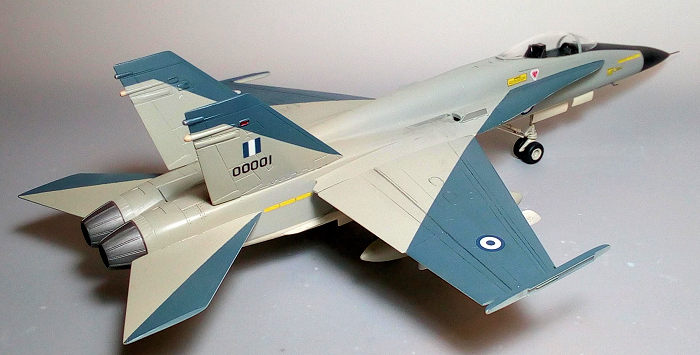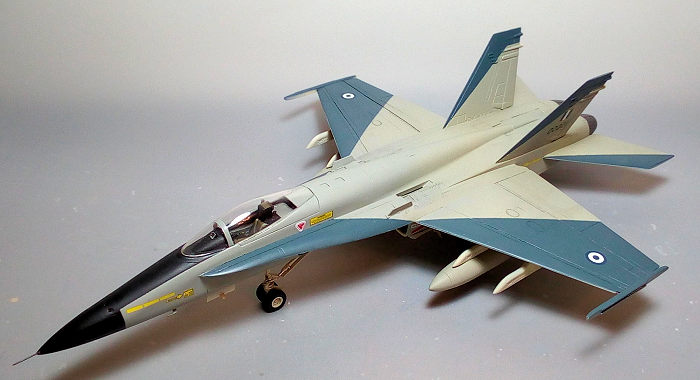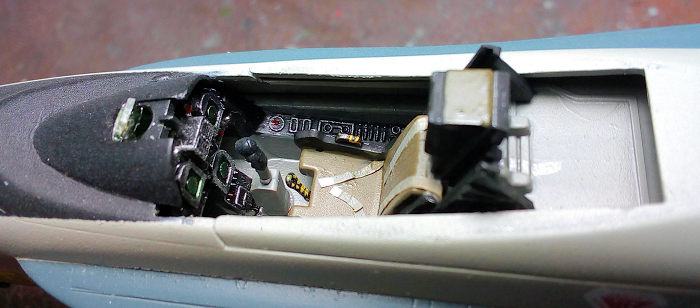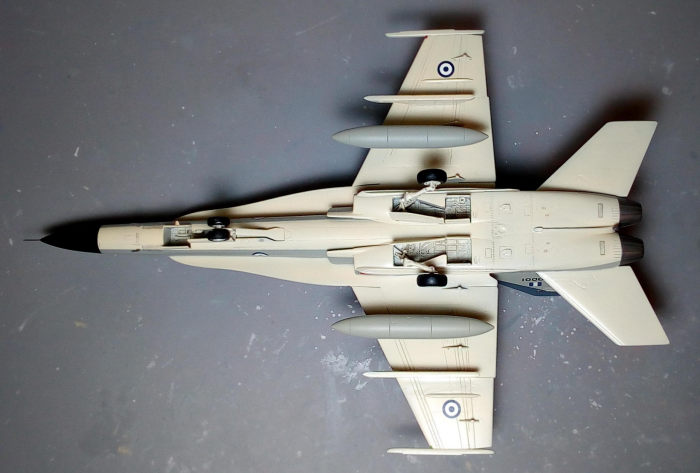
| KIT #: | 71116 |
| PRICE: | €10 in 2004 |
| DECALS: | Two options |
| REVIEWER: | Spiros Pendedekas |
| NOTES: |

| HISTORY |
Back in the late seventies, where the F-18 project was in good progress, Northrop and McDonnell Douglas partner companies were individually progressing with their F-18L land based version designs, in order to attract potential customers. Both designs had the F-18A as the starting point and generally opted for weight reduction, not only by deleting unwanted naval equipment (such as the wing folding mechanism), but also by lightening or simplifying some of the plane’s parts (such as the landing gear and its supporting structure).
The Northrop design would additionally feature deletion of the internal wing tanks and intake mounted weapon stations (but would provide a third underwing one). Both designs would be strengthened for a 9 g design load factor, compared to the F-18A’s 7.5 g.
 Competition
for potential foreign sales inflamed the two companies’ partnership with
lawsuits and the like. Upon the time of the settlement (which was the mid 80’s),
Northrop had already ceased work on the F-18L. Following customers’ preference
for the standard Hornet, McDonnell Douglas seemingly also ceased work on their
land based version (which was by then assigned as F/A-18L), meaning that finally
both companies' “L” versions were left as projected aircraft.
Competition
for potential foreign sales inflamed the two companies’ partnership with
lawsuits and the like. Upon the time of the settlement (which was the mid 80’s),
Northrop had already ceased work on the F-18L. Following customers’ preference
for the standard Hornet, McDonnell Douglas seemingly also ceased work on their
land based version (which was by then assigned as F/A-18L), meaning that finally
both companies' “L” versions were left as projected aircraft.
The land based version of the Hornet competed for the Hellenic Air Force (HAF) fighter contract in the early 1980s. Presumably, both Northrop and MD presented their designs. Interestingly, a blurred color pic exists from that time, depicting a flight of a lavishly painted YF-17 Cobra (from which the standard F-18 emerged), carrying HAF insignia! Seemingly, Northrop performed such “promotion” flights, with the Cobra being a demonstrator of the projected F-18L.
| THE KIT |
Kangnam is a Korean plastic model company that seems to have been active roughly during all 90s till mid 00s decade, with many (if not all) of their kits looking like copies of other companies’ models. This one hit the shelves in 2001. Attracted by the very cheap price and the shiny, sturdy box, I grabbed one of the last remaining pieces from an Athens hobby shop, back in 2004.
Inside the nice top opening box resided about 65 well cast pieces in two greenish gray styrene sprues, two fuselage halves and a clear sprue, all sealed together in a single bag (meaning expecting potential scratches especially regarding the transparencies…). Upon examining the pieces it soon becomes evident that this kit was created by using both the venerable Monogram and Italeri F-18 kits as bases, the result being a kind of "amalgamation copy" of the above kits, but with engraved panel lines!
The fuselage is split
in top and bottom halves a-la-Monogram, the main wings are a two piece affair,
whereas the fins and stabilators are one piece. Cockpit detail is not bad, with
raised details on instrument panel and
 side
consoles, only the seat looks a tad simplistic. Landing gear parts seem like
Monogram copies and look very nice, including brake lines. Wheel bays have
“ribbed” walls, feature some extra detail and have sufficient depth. All panel
lines are engraved and look good, with the many (characteristic for the Hornet)
vent grids nicely represented.
side
consoles, only the seat looks a tad simplistic. Landing gear parts seem like
Monogram copies and look very nice, including brake lines. Wheel bays have
“ribbed” walls, feature some extra detail and have sufficient depth. All panel
lines are engraved and look good, with the many (characteristic for the Hornet)
vent grids nicely represented.
The canopy is one piece, well molded and clear. Instructions are really funny,
as it is obvious that they are poor matches of cropped pieces from both the
Monogram and the Italeri instructions, with the result at places confusing,
especially for the inexperienced modeler.
Where this kit completely fails is at the decals and painting suggestions: not only decals (though of good material quality) look toy-ish, but also the second option refers to a dual seater Hornet, whereas such option is not provided by the kit parts!
Instead of the obvious decision to obtain a decent decal sheet and proceed to a “standard” Hornet, a weird idea crossed my mind: how about depicting a what-if McDonnel Douglas land based demonstrator? In my imaginative scenario, this prototype would have emerged from a preproduction “standard” Hornet and would feature all late aerodynamic improvements (LEX fences and reduction of air discharge slots, among others). For type uniformity, it would have retained the Hornet’s basic landing gear, but without the launch bar and would feature a simpler, lighter arresting hook. A pitot tube would still be found at the radome tip, (“for telemetry purposes”, as it was stated to the Greek Officials), with plans to relocate it at production aircraft.
As an “alternate history”, this what-if demonstrator, painted in an eye-catching “demo scheme” and carrying HAF insignia, would have been presented to the HAF officials and evaluated by HAF test pilots during the fighter contract competition!
| CONSTRUCTION |
I started by joining the two fuselage halves, with the cockpit tub and instrument panel trapped in between. I then attached the top instrument cover, the stick and the canopy base framing which is a nice, separately provided piece. Basic cockpit color was Hu140 Gull Gray with black instrument panel, side consoles, grip and anti glare panel. The instrument panel was dry brushed with silver and, together with side consoles and grip, had red and yellow knobs done with a 10/0 brush. Blobs of clear green paint were put into the radar screens and the HUD projector recessions, with the result being nice.
 I
beefed up the kit seat by using some leftover launch rails. It was painted black
with olive drab cushions and top parachute cover and yellow/black ejection and
quick-release handles. Seat belts, made from masking tape, were added. The seat
was then installed, together with a HUD glass, cut from a clear acetate sheet.
With the above done, the cockpit was deemed passable under a closed canopy.
I
beefed up the kit seat by using some leftover launch rails. It was painted black
with olive drab cushions and top parachute cover and yellow/black ejection and
quick-release handles. Seat belts, made from masking tape, were added. The seat
was then installed, together with a HUD glass, cut from a clear acetate sheet.
With the above done, the cockpit was deemed passable under a closed canopy.
I proceeded by adding the nose, air intakes, 2-piece wings, elevators, rudders and the intakes weapon stations. Alignment of the aerodynamic surfaces was easy, since a head-on view is provided by the instructions. The airbrake was attached in “closed” position, as well. Its shape does not totally follow the surrounding fuselage contours, meaning it was mainly designed to be attached "open".
A coarse sanding took place, followed by attaching of the more delicate underwing actuator covers, underwing pylons, wingtip rails and LEX fences. General fit, despite initial concerns, was not bad, but small amounts putty were required at many joints. The two drop tanks were assembled at this stage, as well.
After a progressive up to 1500 grit sanding, I masked off the cockpit and took this beauty to the paint shop, in order to apply my what-if scheme, which would be heavily based on the YF-17 Cobra demo scheme, during its evaluation by the Hellenic Air Force!
| COLORS & MARKINGS |
 I started by
painting the nose and top antiglare panel black (Hu33), then masked them off. I
proceeded by painting all undersides white (Hu22), including doors, bays, intake
innards, landing gear legs and wheel rims. After masking off the model white
areas, I applied a coat of Hu127 ghost gray, which was also masked. The wing
tanks were painted the same gray, as well. Final color was Hu144 Intermediate
Blue. The intakes shallow and bland ends were painted matt black, as to provide
an illusion of depth. Upon removing the masks, an eye catching what-if scheme
emerged!
I started by
painting the nose and top antiglare panel black (Hu33), then masked them off. I
proceeded by painting all undersides white (Hu22), including doors, bays, intake
innards, landing gear legs and wheel rims. After masking off the model white
areas, I applied a coat of Hu127 ghost gray, which was also masked. The wing
tanks were painted the same gray, as well. Final color was Hu144 Intermediate
Blue. The intakes shallow and bland ends were painted matt black, as to provide
an illusion of depth. Upon removing the masks, an eye catching what-if scheme
emerged!
After applying a coat
of Future to all surfaces, I proceeded to decaling. HAF insignia were taken from
a generic “Kalfakis – Afterburner” decal sheet (excellently printed by Cartograf,
sadly OOP). Generic digits were used to represent the plane’s supposed s/n
“00001” onto the fins. I pushed myself and used the kit provided stencils, which
in general looked passable, with the exception of the formation lights that
looked too “yellow” (I used them anyway…).
A coat of Future sealed all decals.
| FINAL CONSTRUCTION |
Landing gear legs had their oleos accentuated by my fine silver pen and were attached in position. Since this was supposed to be a land version, the carrier launch bar was not installed. I assembled the wheels and sanded their tire section smooth, filed them a tad to look weighted, painted their tires black and attached them in place. A nose pitot as fabricated from a needle piece, painted gunmetal and attached. The wing tanks were attached too.
 The
two piece good looking nozzles were assembled, painted Testors burned metal and
affixed in position. Since it was supposed to be a demonstrator, minimal
weathering was performed, mainly highlighting airframe engraved details and
landing gear areas with judicious blackwash. A final satin cote gave the bird
its final finish.
The
two piece good looking nozzles were assembled, painted Testors burned metal and
affixed in position. Since it was supposed to be a demonstrator, minimal
weathering was performed, mainly highlighting airframe engraved details and
landing gear areas with judicious blackwash. A final satin cote gave the bird
its final finish.
The one piece canopy had its framing hand painted and was subsequently attached in place with tiny amounts of styrene glue. Finally, blobs of red and green clear paint represented the navigation lights, before calling this beauty done!
| CONCLUSIONS |
Whereas out of production (seemingly for good) and almost impossible to find today (as of 2021), this very cheap kit (which is an “amalgamated copy” of the Monogram and Italeri offerings), was a simple (details-wise) but solid kit with good fit, that produced a passable F-18 model. The patched together foggy instructions could present some difficulty to the novice modeler, who may otherwise tackle this kit easily.
I had a pleasant time putting it together, implementing my what-if scenario, with the he final result being a colorful bird that could pass as a land based Hornet demonstrator (or mock up).
Who could have ever imagined a what-if McDonnel Douglas F-18 Hellenic Air Force demonstrator?
Happy modeling!
14 March 2022
Copyright ModelingMadness.com. All rights reserved. No reproduction in part or in whole without express permission.
If you would like your product reviewed fairly and quickly, please contact the editor or see other details in the Note to Contributors.